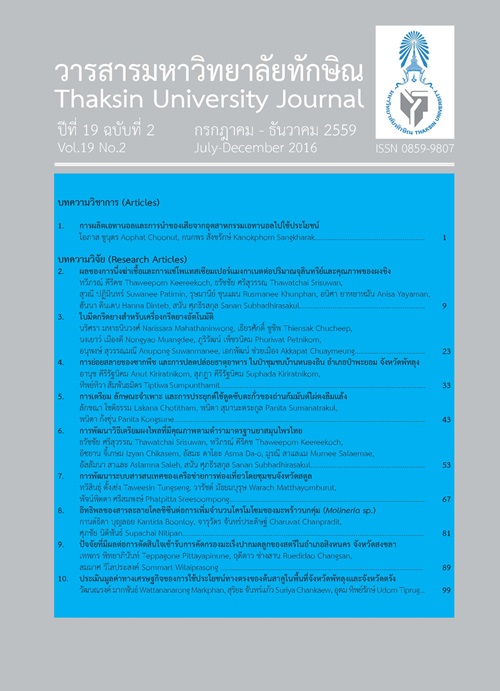Development of the Preparation Methods for Qualified Cassumunar Ginger Powder Based on Thai Herbal Pharmacopoeia Standards
Main Article Content
Abstract
For the development preparation methods for qualified cassumunar ginger powder (Zingiber
cassumunar Roxb.) based on Thai Herbal Pharmacopoeia, fresh cassumunar ginger rhizome was
divided into 3 groups with a total of 5 treatments. The first group was sterilized by steam at 121°C or
115°C for 15 minutes. The second group was soaked into potassium permanganate solution (KMnO4)
at a concentration of 100 ppm or 200 ppm for 15 minutes. The third group was the untreated control
group which was untreated. The results showed that the steam sterilization of the rhizomes at 121°C
for 15 minutes passed all the standards of Thai Herbal Pharmacopoeia, while the other 4 treatments
had microbial contamination. The components in volatile oil were determined by GC-MS. The ratio
of components contents in volatile oil which was sterilized at 121 °C for 15 minutes in the treatmen
sample were different from that of the control group. It was consisted of Triquinacene, 1,4-bis (methoxy)
(48.86%), Terpinene-4-ol (8.49%), Sabinene (6.94%), 2-Allyl-1,4-dimethoxy-3-methyl-benzene
(6.12%) and β-Sesquiphellandrene (6.09%). The percentage of the relative peak area of major components
in the steam sterilization of the rhizomes at 121°C for 15 minutes treatment sample was
lower than that of the control group. However, steam sterilization of the rhizomes at 121°C for 15
minutes was a suitable preparation method for qualified cassumunar ginger powder.
Article Details
References
พัฒนาระบบยาแห่งชาติ (ฉบับที่ 4) พ.ศ. 2554. กรุงเทพฯ: สามเจริญพาณิชย์.
[2] นันทนา กลิ่นสุนทร ชมพูนุท นุตสถาปนา และปริชญา มาประดิษฐ. (2557). “การส?ำรวจคุณภาพยาสมุนไพร
ในเขตสาธารณสุขที่ 4 และ 5”, วารสารกรมวิทยาศาสตร์การแพทย์. 56(1), 40-51.
[3] จิตรา ชัยวัฒน์ จิรานุช แจ่มทวีกุล สันติพงศ์ วงศ์เพ็ญทักษ์ และปรัชญาพร อินทองแก้ว. (2557). “ความปลอดภัย
ของยาจากสมุนไพรในบัญชียาหลักแห่งชาติ”, วารสารกรมวิทยาศาสตร์การแพทย์. 56(3), 123-134.
[4] เชาวลิต มณฑล. (2556). “การฉายรังสีแกมมา: กระบวนการท?ำไร้เชื้อส?ำหรับผลิตภัณฑ์สมุนไพร”, วารสารไทย
ไภษัชยนิพนธ์. 8(1), 41-54.
[5] Chusri, S., Subhadhirasakul, S., Tahyoh, N., Billateh, C., Chaowuttikul, C., Chorachoo, J. and
Voravuthikunchai, S.P. (2012). “Effect of Different Decontamination Methods on
Microbiological Aspects Bioactive Constituents and Antibacterial Activity of Turmeric
(Curcuma longa Linn.) Powder”, European Journal of Medicinal Plants. 2(4), 276-289.
[6] ทวีภรณ์ คีรีคช ธวัชชัย ศรีสุวรรณ รอกีเยาะ ตาเละ โรสนานี เหมตระกูลวงศ์ สาปีน๊ะ เจ๊ะสะอิ และสนั่น ศุภธีรสกุล.
(2557). “ผลของเวลาและอุณหภูมิในการนึ่งฆ่าเชื้อต่อคุณภาพของผงขมิ้นชัน”, วารสารมหาวิทยาลัยทักษิณ.
17(1), 57-67.
[7] Sukul, S. and Sheth, M. (2012). “Can Sanitizers Reduce Microbial Load of Coriander Leaves”,
Nutrition & Food Science. 42(1), 12-20.
[8] Ministry Of Public Health. (2009). Thai Herbal Pharmacopoeia. Vol.1. Department of Medical
Sciences, Bangkok: Prachachon.
[9] Ministry Of Public Health. (2009). Thai Herbal Pharmacopoeia. Vol.3. Department of Medical
Sciences, Bangkok: Prachachon.
[10] Sukrasno, Waningsih E.S. and Fidrianny, I. (2014). “Heating Effect of Ginger (Zingiber officinale Rosc)
in Content of Volatile Oil and Oleoresin”, International Journal of Research in
Pharmaceutical Sciences. 5(2), 132-136.
[11] Sukattal, U., Rugthaworn1, P., Punjee1, P., Chidchenchey, S. and Keeratinijakal, V. (2009).
“Chemical Composition and Physical Properties of Oil from Plai (Zingiber cassumunar Roxb.)
Obtained byHydro Distillation and Hexane Extraction”, Kasetsart Journal - Natural Science.
43(5), 212-217.
[12] Bua-in, S. and Paisooksantivatana, Y. (2009). “Essential Oil and Antioxidant Activity of Cassumunar
Ginger (Zingiberaceae: Zingiber montanum (Koenig) Link ex Dietr.) Collected from Various
Parts of Thailand”, Kasetsart Journal - Natural Science. 43(3), 467-475.
[13] Bhuiyan, N.I., Chowdhury, J.U. and Begum, J. (2008). “Volatile Constituents of Essential Oils
Isolated from Leaf and Rhizome of Zingiber cassumunar Roxb”, Bangladesh Journal of
Pharmacology. 3, 69-73.
[14] Singh, C.B., Manglembi, N., Swapana, N. and Chan, S.B., (2015). “Ethnobotany, Phytochemistry
and Pharmacology of Zingiber cassumunar Roxb. (Zingiberaceae)”, Journal of Pharmacognosy
and Phytochemistry. 4(1), 01-06.


